Center for Community Support and Development Studies, Real-Time Analytics and United Nations Development Program
 |
| Hanoi Public Administration Service Center - Branch No. 1 (at 258 Vo Chi Cong street, Tay Ho district)__Photo: VNA |
Introduction
This article presents key findings from the 16th edition of the Vietnam Provincial Governance and Public Administration Performance Index (PAPI)[1] survey regarding citizens’ assessment of governance and public administration performance at the provincial level in 2024, offering a comparative perspective of the first four years of the 2021-26 government term. The 2024 PAPI Report captures and amplifies the voices of 18,894 respondents from 61 provinces[2] in Vietnam. Through their everyday experiences, these respondents paint a comprehensive picture of central and provincial government performance throughout the year in the areas of governance, public administration, and public service delivery.
Importantly, having passed the midway point in the 2021-26 government term, PAPI’s 2024 findings offer valuable insights into citizens’ perceptions of governance over the past 12 months and how they compare to earlier period in the term. They also provide local governments with instructive time-series comparisons to measure performance against citizens’ expectations and identify areas for action required during the term’s final phase.
This article[3] highlights key findings at the provincial level across all eight PAPI dimensions (i.e., Participation at Local Levels, Transparency in Local Decision-making, Vertical Accountability Toward Citizens, Control of Corruption in the Public Sector, Public Administrative Procedures, Public Service Delivery, Environmental Governance, and E-Governance) as well as at the aggregate level from 2021 to 2024. This reveals how sub-national government agencies performed in their fourth year of the current 2021-26 term from the citizens’ perspective. It also points to policy implications relevant for provincial- and grassroots-level decision-makers and practitioners in all provinces in 2025 and beyond. The findings will also provide essential considerations for central- and provincial-level government restructuring from July 2025, especially in identifying good practices for merged provinces and communes to carry on after restructuring.
Dimension 1: Participation at Local Levels
The Participation at Local Levels dimension measures citizens’ awareness of their right to political participation, how they participate in elections and local decision-making, as well as how local governments facilitate these rights in accordance with the 2022 Law on Practice of Grassroots Democracy.
· Citizen engagement a mixed bag at the local level. Nearly half of 61 provinces improved citizen engagement in local governance in 2024 compared to 2021. While 28 provinces posted significant increases, eight provinces experienced notable declines and 22 peers saw little improvement.
· Key steps forward in civic knowledge, but regional disparities persist. Upward trends in citizens’ understanding of policy and leadership nationwide were a notable driver of enhanced civic knowledge performance, but provincial variations highlight regional disparities in civic awareness.
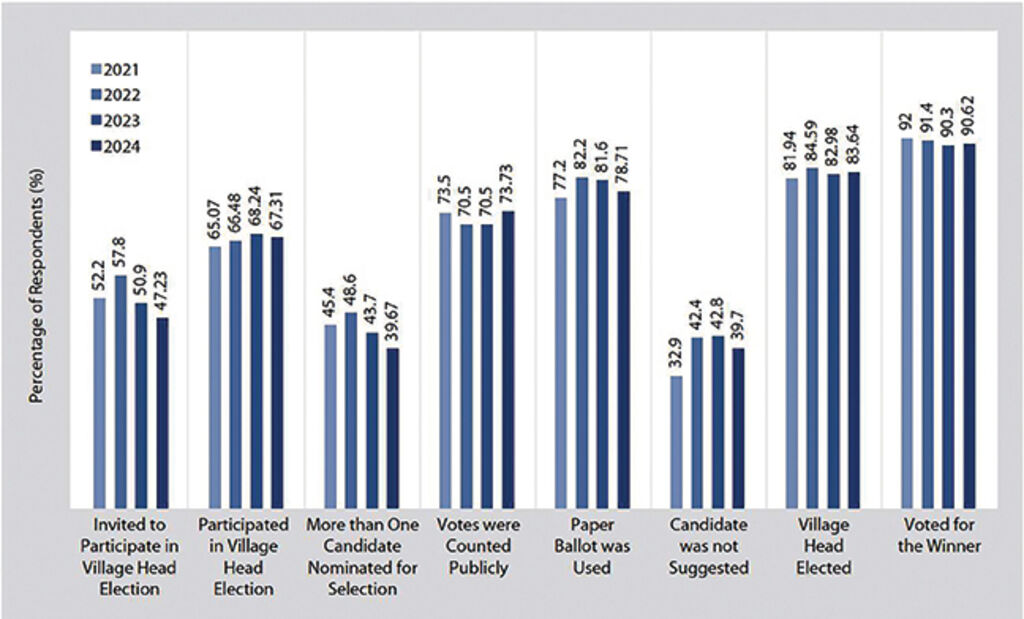 |
| Figure 1: Trends in village head elections during 2021-24 |
· Declining participation and choices in village head elections, coupled with shifts in voluntary contributions. Village head election trends reveal a decline in citizen participation and candidate choices in the four years to 2024, with fewer citizens invited to participate and multiple-candidate elections less common (see Figure 1). While citizens’ voluntary contributions to local infrastructure projects increased, direct participation in implementation diminished.
Dimension 2: Transparency in Local Decision-making
PAPI measures how local governments facilitate access to government information and respond to civic rights to understand how public policies impact citizens’ lives and livelihoods across four sub-dimensions: (i) Access to Information, (ii) Transparency in Poverty Lists, (iii) Transparency in Commune Budget and Expenditure, and (iv) Transparency in Local Land Use Planning and Pricing.
· Shifting regional distribution of high-performing provinces. In 2024, a more regionally diverse picture of top performers emerged, unlike previous years dominated by northern provinces. Notably, 31 high and mid-high performing provinces were spread across five of six economic regions, excluding the Central Highlands.
· Persistent low scores and limited progress in transparency of local decision-making. Provincial scores remained subdued in 2024, continuing a trend from the early 2020s. Scores ranged from 4.42 to 6.23 out of 10, indicating limited overall progress. Additionally, while around a third of provinces posted gains compared to 2021, a similar number remained stationary (see Figure 2).
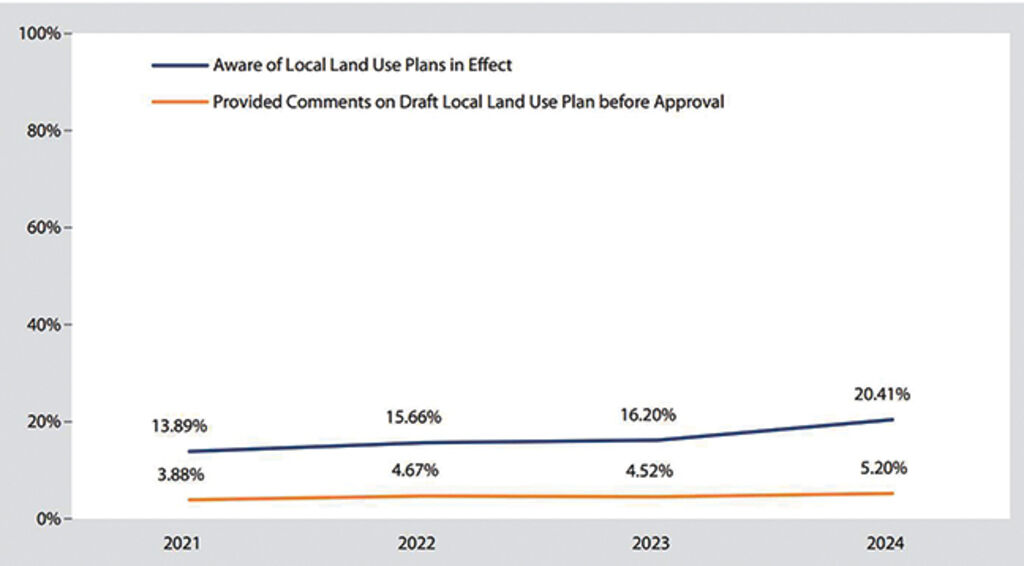 |
| Figure 2: Trends in disclosure of land use plans and citizens’ opportunity to provide comments on draft land use plans over 2021-24 period |
· Opaque transparency in local information, with gaps in access and participation. While provinces generally received positive feedback for transparent poverty lists, significant gaps remain in public access to information. Scores for Access to Information were undercut by those for Transparency in Poverty Lists. Furthermore, incremental progress in disclosing commune budgets and land use plans, was not seen in citizens’ ability to provide feedback on these plans (see Figure 2).
Dimension 3: Vertical Accountability Toward Citizens
This dimension consists of three sub-dimensions: (i) Interaction with Local Authorities, (ii) Government’s Responsiveness to Citizen Appeals, and (iii) Access to Justice Services. Together, they reflect how local governments respond to citizens’ requests, proposals, denunciations, complaints, petitions and examine citizens’ trust in courts and judicial agencies.
· Regional dispersion and persistent low scores in vertical accountability. In 2024, high-performing provinces in vertical accountability displayed a broader geographic spread, notably present in North Central and Central Coastal regions, diverging from earlier years. However, scores remained low overall with the Local Governments’ Responsiveness to Citizens’ Appeals sub-dimension consistently underperforming, while Access to Justice Services also revealed significant room for improvement nationally.
 |
| Figure 3: Four-year difference in provincial performance in Vertical Accountability Toward Citizens, 2024 against 2021 |
· Stagnation in accountability improvement and limited progress over time. A systemic national challenge is evident with little headway made in enhancing accountability toward citizens at local levels since 2021 (see Figure 3). Underlining the challenge for policymakers to deliver more effective strategies, the majority of provinces are treading water or even regressing, with only a small number making meaningful improvements.
· Citizen reliance on village heads and stable trust in judicial systems. Citizens exhibited a clear preference for seeking assistance from village heads and commune People’s Committee officials instead of other local entities. Trust in local courts and judicial agencies remained stable during 2021-24, as did the reported use of court and non-court mechanisms for dispute resolution, suggesting consistent patterns in citizen behavior and perceptions.
Dimension 4: Control of Corruption in the Public Sector
This dimension is comprised of four sub-dimensions: (i) Limits on Corruption in Local Governments, (ii) Limits on Corruption in Public Service Delivery, (iii) Equity in State Employment, and (iv) Willingness to Fight Corruption. The sub-dimensions measure the performance of public institutions and local governments in controlling corruption in the public sector and reflect citizens’ tolerance of corrupt practices.
· Anti-corruption efforts characterized by patchy regional and provincial performances. Southern provinces emerged as more robust opponents of public sector corruption in 2024, with nine of 15 high performers located in the Southeastern and Mekong Delta regions (see Figure 4). In contrast, several centrally run municipalities and Central Highlands provinces were off the pace. Provincial scores varied significantly, with Limits on Corruption in Public Service Delivery being the primary positive contributor. Overall, more provinces made progress in 2024 compared to 2021.
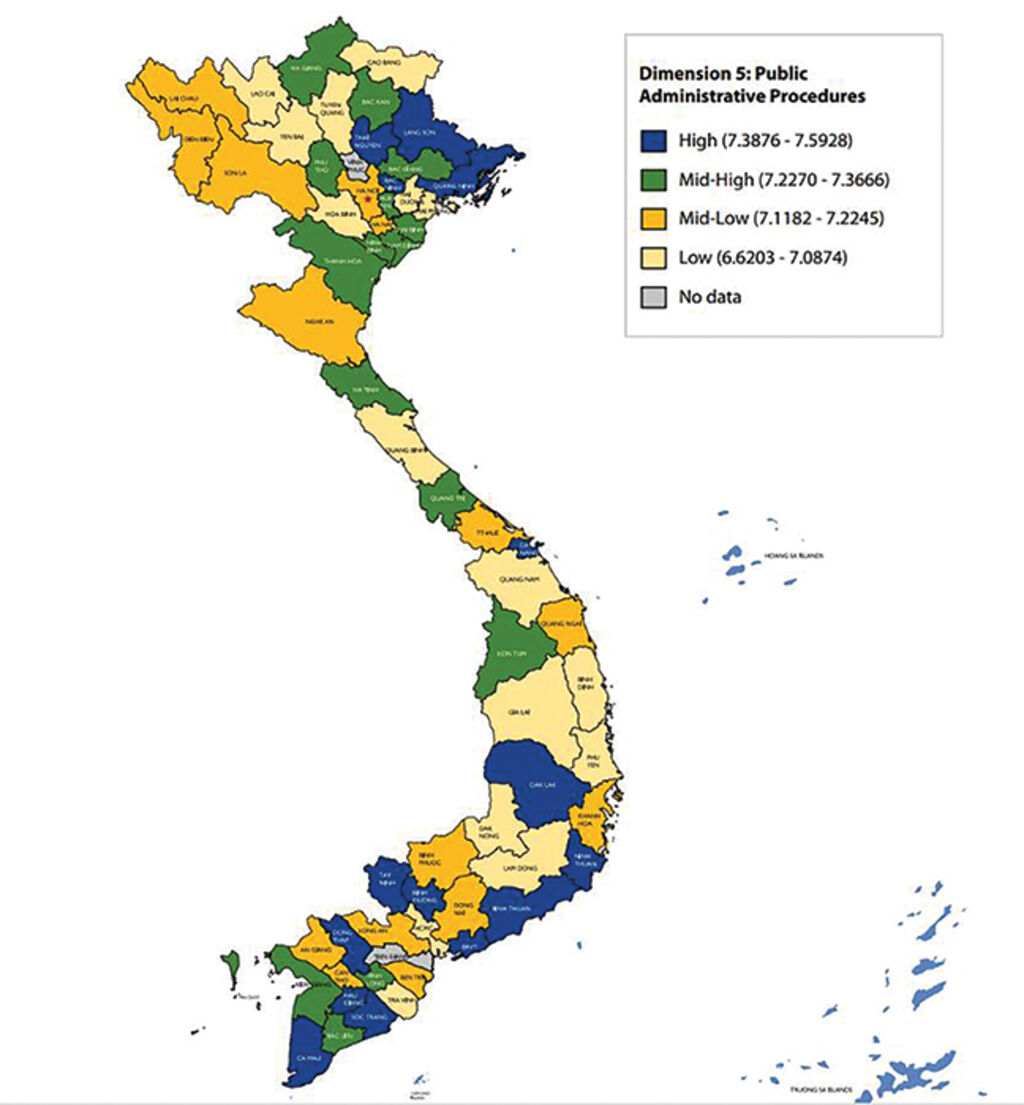 |
| Figure 4: Provincial performance in control of corruption in 2024 by quartile |
· Persistent challenges in equity and transparency within state employment. Equity in State Employment remained an Achilles heel for many provinces, despite some improvements. Provincial scores were low, with bribery and nepotism prevalent. Personal relationships continued to play a significant role in securing public sector employment, even in high-performing provinces. This highlights a systemic issue that requires further attention to ensure fair and equitable access to state employment.
· Widespread bribery in surveyed essential public services, particularly land use rights certification and public healthcare. Bribery for land use rights certificates and optimal care at district public hospitals remained common across all provinces. Significant variations in prevalence were observed, with higher rates reported in specific regions and provinces. This underscores the need for targeted interventions to ensure corruption does not blight essential public services.
Dimension 5: Public Administrative Procedures
This dimension reflects the quality of three public administrative services: (i) Certification Services by Local Governments, (ii) Application Procedures for Land Use Rights Certificates, and (iii) Application Procedures for Personal Documents handled by Commune Governments. As such, it examines the professionalism and responsiveness of provincial to commune government staff in providing public administrative services.
· Regional variations and municipal disparities in public administrative service delivery. The Southeastern and Mekong Delta regions contributed significantly to the high-performing group in public administrative procedures, yet major municipalities like Hai Phong and Ho Chi Minh City lagged. Da Nang city was the only municipality in the high-performing quartile.
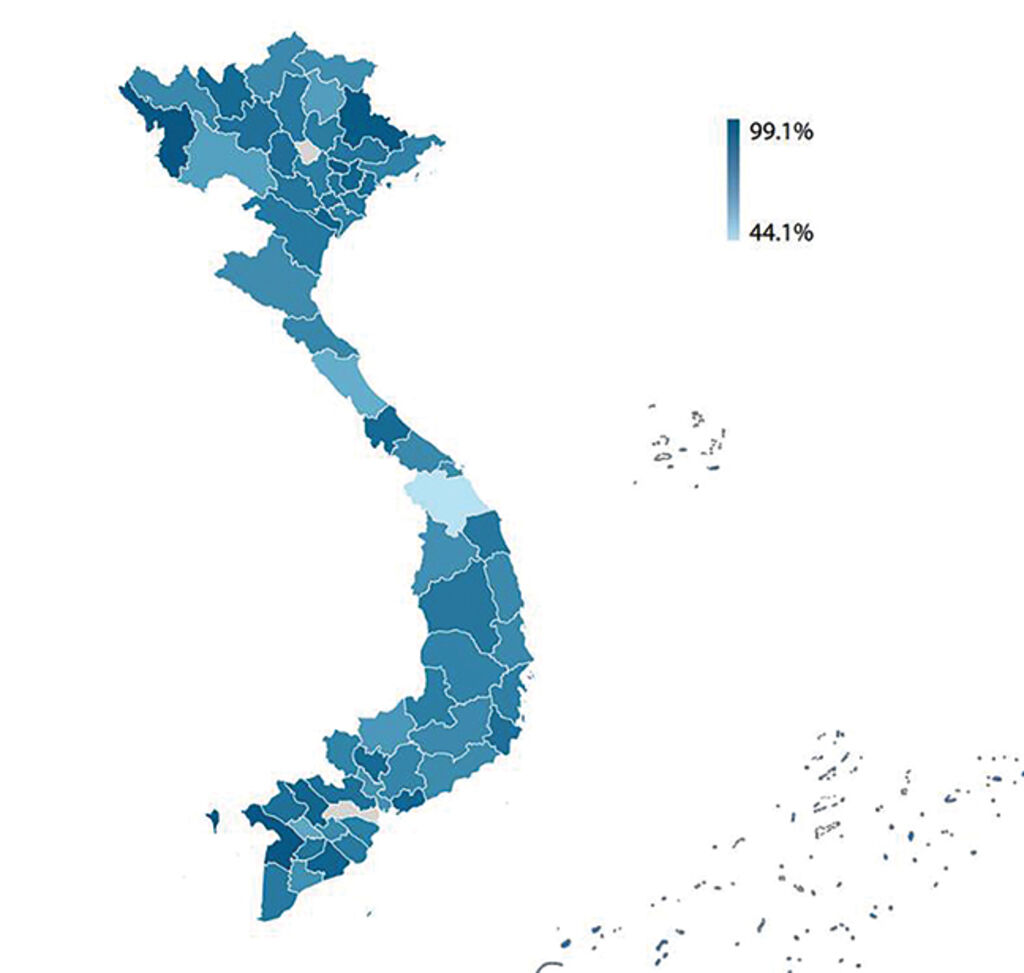 |
| Figure 5: Access to one-stop shop services for land use rights certificates in 2024 |
· Stagnation and minor declines in provincial performance. Provincial performance in public administrative procedures stagnated in 2024, with a slight decrease in overall score range. While some provinces like Ba Ria-Vung Tau and Dak Lak showed some bright spots, the pervading stagnation requires a step change from provinces to ensure their citizens benefit from optimized public administrative services.
· Challenges in enhancing transparency and efficiency in public administrative services, especially at the district level. The lack of transparent application fees at commune one-stop shops (OSSs) negatively impacted citizen satisfaction. Also, delays in processing procedures and issuing land use rights certificates at district OSSs were a significant concern. Additionally, significant differences in accessibility of OSS services between commune and district levels were apparent, with the former rated more efficient. In particular, the proportion of land use rights certificate applicants who did not see civil servants at district OSSs to get procedures processed ranged from 44 percent to 99 percent (see Figure 5), wider than the proportions of applicants saying they did not meet officials to process paperwork at commune OSSs, which ranged from 87 percent to 100 percent.
Dimension 6: Public Service Delivery
This dimension looks at four public services: (i) public health care, (ii) public primary education, (iii) basic infrastructure, and (iv) law and order. To explore this dimension, citizens were asked about their direct experiences with the accessibility, quality and availability of these services.
· Regional disparities in public service delivery performance. Coastal areas were strong performers in public service delivery, with provinces like Ba Ria-Vung Tau, Da Nang, and Khanh Hoa leading the way. In contrast, the Northern Midlands and Mountainous region as well as the Mekong Delta region were off the pace.
· Overall improvements, but provinces struggled to break the status quo. While provincial public service delivery performance showed overall improvements in 2024 compared to a year earlier, a considerable number experienced stagnation. Key challenges remain, particularly in public primary education, despite progress in law and order.
· Challenges in education and healthcare, contrast with infrastructure improvements. Teacher favoritism in public primary education remains a widespread issue, affecting rich and poor provinces. District public hospitals nationwide require upgrades, with significant concerns about facilities and service quality (see Figure 6). Conversely, improvements in road conditions and garbage collection were reported, with affluent provinces showing better infrastructure quality.
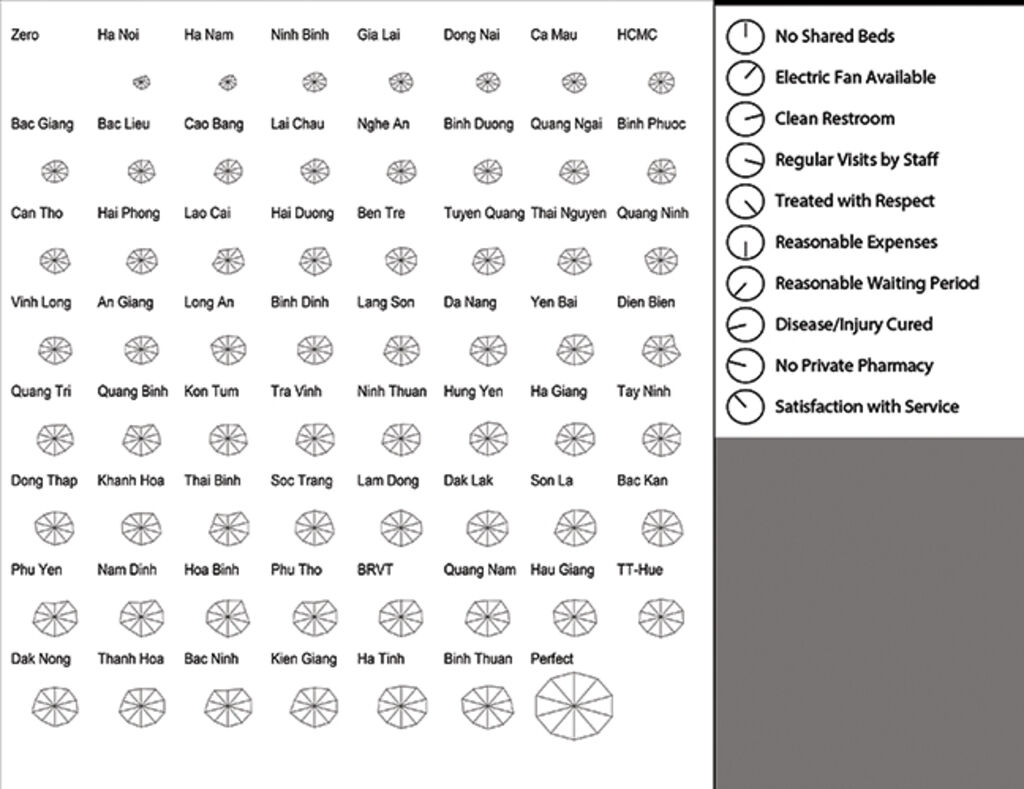 |
| Figure 6: Quality of district public hospitals by province, 2024 |
Dimension 7: Environmental Governance
This dimension reflects citizens’ assessment of environmental aspects of air and water quality, as well as the integrity of local governments and businesses in protecting the environment. It sets some baselines to assist local governments in understanding citizens’ environmental concerns over time.
· Persistent environmental concerns in industrial and economic hubs. Industrial heavyweight provinces in the Red River Delta, Southeastern, and Central Highlands regions continue to be flagged for environmental concerns, highlighting the need for targeted protection strategies. The Mekong Delta, however, demonstrated strong green credentials.
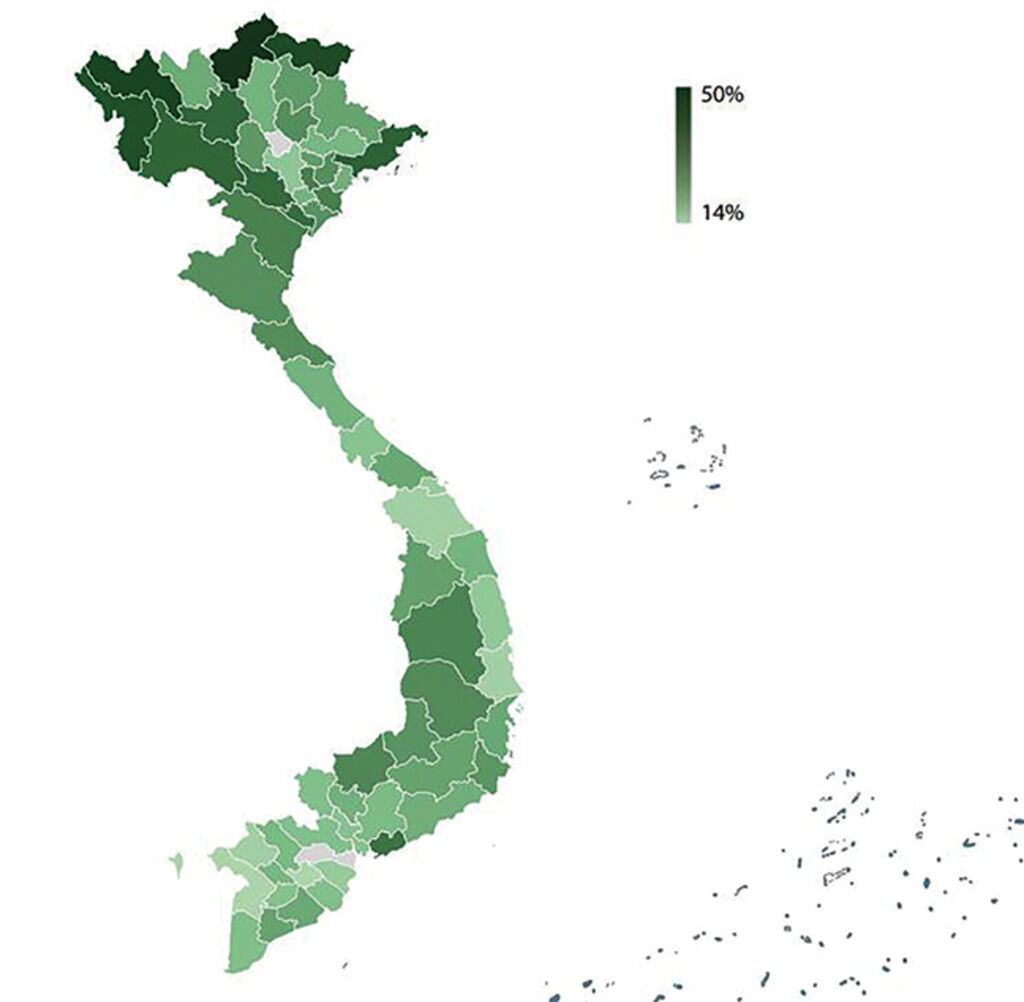 |
| Figure 7: Percentage of citizens not wearing masks to avoid air pollution by province, 2024 |
· Marginal improvements in environmental governance amid low overall scores. While overall scores for environmental governance remain subdued, there were slight improvements in 2024 with a number of provinces also displaying significant progress compared to 2021.
· Local governments’ environmental commitment questioned, with water and air quality key concerns. Low scores reflect a perception that local governments need to strengthen their commitment to environmental protection, especially to address poor domestic water quality to ensure safe drinking and cooking water for citizens. Air pollution also remains top of mind for many citizens, as evidenced by widespread mask usage (see Figure 7), indicating the need for improved air quality management.
Dimension 8: E-Governance
This dimension spotlights citizens’ assessment of key ingredients for e-government: availability, accessibility, user-friendliness and responsiveness of online public services. The dimension provides information on the availability of local government portals for citizens to access policy information and public services, and whether citizens have Internet access - the enabling environment to participate in e-government. It also helps local governments interact with citizens more effectively via online platforms at every stage of the policy cycle - from policy-making and policy implementation to policy monitoring and evaluation.
· Regional disparities in e-governance performance. The Red River Delta region and the Southeastern region emerged as leaders in e-governance in 2024. Conversely, the Mekong Delta and Central Highlands exhibited sub-optimal performance. This highlights a clear regional disparity in e-governance adoption and effectiveness, requiring a strategic and synchronous response from decision-makers.
· Encouraging improvements, despite below-average scores. While scores remain below four points on a scale of one to 10, 50 provinces demonstrated improvements in e-governance performance in 2024 compared to 2023. While no significant declines were recorded since 2021, some provinces like Lam Dong and Nghe An display signs of potential regression and require focused attention.
· Patchy progress in e-governance components and a persistent digital divide. While Internet access significantly contributed to higher e-governance scores, access to and responsiveness of government portals remained limited. A significant digital divide persists, with wide variations in Internet access and e-government portal usage between urban and rural/mountainous areas. This underlines the need for targeted interventions to bridge these gaps and improve overall e-governance accessibility and effectiveness.
 |
| Figure 8: Gaps in access to the Internet and to e-government and e-service portals in 2024 compared to 2021 |
Aggregate 2024 PAPI scores at the provincial level
As an aggregate index, calculated by adding up each province’s scores in the eight PAPI dimensions, PAPI serves as a dashboard that shows a province’s governance and public administration performance in a certain year in a holistic manner. The PAPI findings for 2024, which offer insightful measuring points for governments to elevate performance in the final two years of the 2021-26 government term, reveal:
· Persistent regional disparities in overall governance outcomes. Mountainous and highland provinces generally lagged lowland provinces in overall governance performance in 2024. The Central Highlands region and the Northern Midlands and Mountainous region made up higher concentrations of low-performing provinces, with North Central and Central Coast, Red River Delta and Southeastern provinces at the other end of the spectrum.
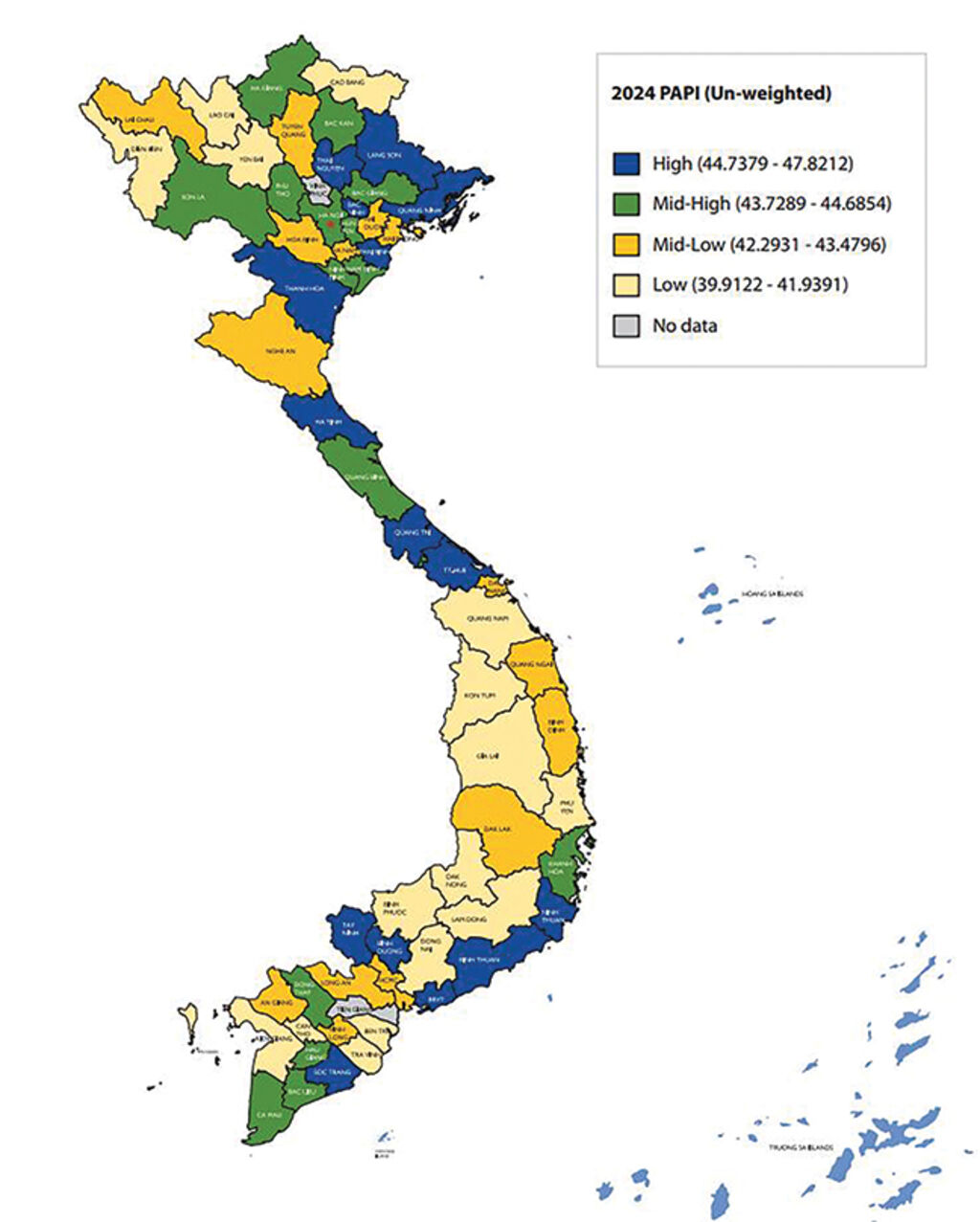 |
| Figure 9: Aggregated 2024 provincial PAPI scores by quartile |
· Provincial aggregate improvements undercut by gaps in performance. Significant gaps in overall governance and public administration performance were evident across provinces in 2024, despite aggregate improvements compared to 2023. Provincial PAPI scores showed a slightly higher range in 2024, offering substantial room for improvement.
· Varied progress across dimensions and disparities for non-permanent residents. Tangible improvements were observed in Control of Corruption in the Public Sector and E-Governance for this cohort of citizens, with some progress in Public Service Delivery at the provincial level. However, across all provinces, significant gaps persisted in Participation at Local Levels, Transparency in Local Decision-making, Vertical Accountability Toward Citizens, Environmental Governance, and E-Governance. Furthermore, non-permanent residents experienced disparities in governance and public administration, particularly in 10 major migrant-receiving provinces, highlighting the need for more equitable access.-
[1] For further information about PAPI and its data by province from 2011-24, visit www.papi.org.vn/eng. PAPI is currently co-funded by the Australian Department for Foreign Affairs and Trade (DFAT), the Embassy of Ireland, and the United Nations Development Program (UNDP) in Vietnam.
[2] Tien Giang and Vinh Phuc provinces did not participate in 2024 PAPI survey.
[3] This article is also a follow-up on the article revealing the national overview of governance and public administration issued on Vietnam Law and Legal Forum in April 2025 at https://vietnamlawmagazine.vn/2024-papi-report-government-reforms-offer-historic-opportunity-to-enhance-local-governance-for-all-74085.html.









